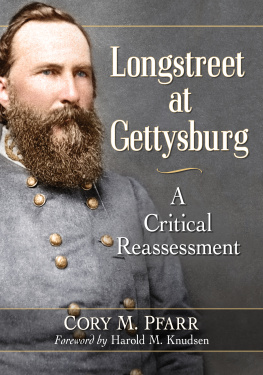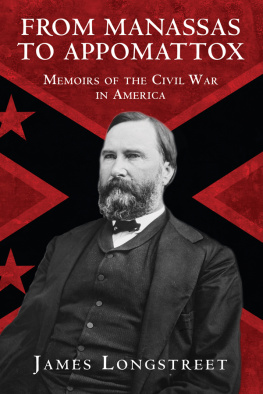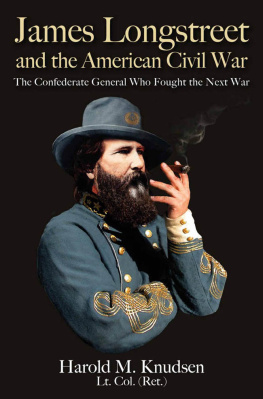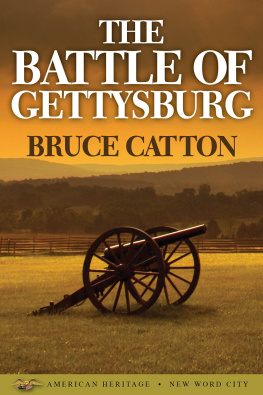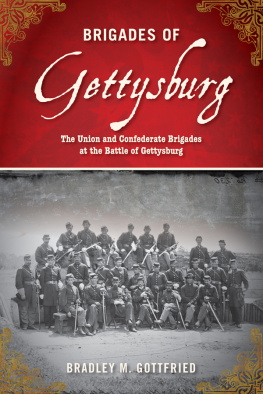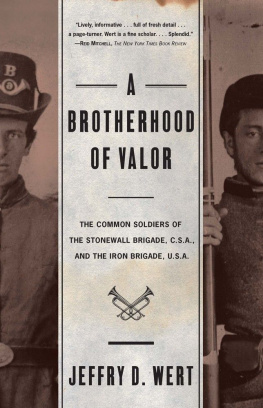
Longstreet at Gettysburg
A Critical Reassessment
Cory M. Pfarr
Foreword by Harold M. Knudsen

McFarland & Company, Inc., Publishers
Jefferson, North Carolina
LIBRARY OF CONGRESS CATALOGUING DATA ARE AVAILABLE
BRITISH LIBRARY CATALOGUING DATA ARE AVAILABLE
e-ISBN: 978-1-4766-3499-9
2019 Cory M. Pfarr. All rights reserved
No part of this book may be reproduced or transmitted in any form or by any means, electronic or mechanical, including photocopying or recording, or by any information storage and retrieval system, without permission in writing from the publisher.
Front cover: James Longstreet, 1863 (courtesy HistoryInFullColor.com)
McFarland & Company, Inc., Publishers
Box 611, Jefferson, North Carolina 28640
www.mcfarlandpub.com
For God; my wife, Michelle;
my children, Anita, David, and Abigail;
and the rest of my family.
Acknowledgments
First and foremost, I would like to thank my wife, Michelle, for her constant encouragement and support throughout the entirety of this four-year project and for reading and offering suggestions on multiple drafts of this book. Her and my childrens patience and understanding when I sometimes spent hours at a time in my study researching, writing, or editing was greatly appreciated. I would also like to thank Dr. Charles F. Ritter for his advice and guidance throughout the writing and editing process. Dr. Ritter always made himself available to answer any question or concern I had in a timely manner. Lastly, I would like to express gratitude to the McFarland editorial team for making the publication experience so pleasant and efficient.
Maps
Maps by Hal Jespersen
Foreword
by Harold M. Knudsen
Upon the death of Robert E. Lee in 1870, several of General James Longstreets contemporaries who sought to discredit him for his postwar politics took aim at his war record in order to accomplish their character assassination. This led to a century-and-a-half-long assault from many writers in different periods who invented one falsehood after the next on why Lee was defeated at Gettysburg. Nearly all these falsehoods attributed the defeat to Longstreet for one reason or another. For the first time ever, a writer has taken on the considerable task of looking at every single one of these charges against Longstreet regarding Gettysburg, analyzing them for their motive, for their plausibility, and then showing why they are false. Cory Pfarrs work is a powerful broadside that demolishes each one.
From the first books written in the decades after the war, to the Lost Cause era that gained full steam generally in the 1890s through the 1930s, and on to the second generation of Lost Cause writers like Douglass Southall Freeman in the 1940s, these groupthink narratives about Gettysburg were continuously reinforced and repeated from one book to the next. Audiences were trained to believe what writers said as gospel, rather than educated to examine the true records. Perhaps in the 1960s the historical novel The Killer Angels provided the first respite from the negativity about Longstreet that at least showed him in a fictional setting as a consummate professional who cared about helping Robert E. Lee. From this came a few later books and magazine articles that began to re-evaluate and re-educate the public on Longstreet slowly into the 2000s and out to today. None, however, have addressed Longstreet at Gettysburg solely like this fine work has.
From all of Longstreets interactions with Lee, to his battle preparations and his execution of the plans, Pfarr shows a mastery of thorough research: how to use historical primary sources to debunk incorrect secondary source historiography. All three days of Gettysburg get a full treatment in this work through a unique angle. It is truly a fresh and original look at Gettysburg, and anyone who cares about the truth of Longstreets place in the record that is Gettysburg should read this tour de force of historical method.
Harold M. Knudsen, a retired Army lieutenant colonel, is the author of General James Longstreet: The Confederacys Most Modern General. He lives in Alexandria, Virginia.
Prologue: Abandoned by History
The faithful historian of the future will assign him his dueJohn H. Leathen
Gainesville, Georgia, mid1890s: After enduring a sixteen-hour trip in a Pullman Car, Hamlin Garland, the turn of the twentieth century American essayist and novelist, walked through a town so distinctively of the mountain south, it engendered a sense of having entered another world. Meandering his way along dirt roads, he imagined a large, old-fashioned southern place, with pillars wide and tall as his final destination, but instead found a tree with a board nailed to it, reading Wine for Sale. Across the road was a sizable vineyard and as he walked on, he came upon a lean, farmer-like person, who pointed him toward an ordinary story and a half [sic] farm house, such as a northern carpenter might build.
Youll find him in his vineyard, said the man.
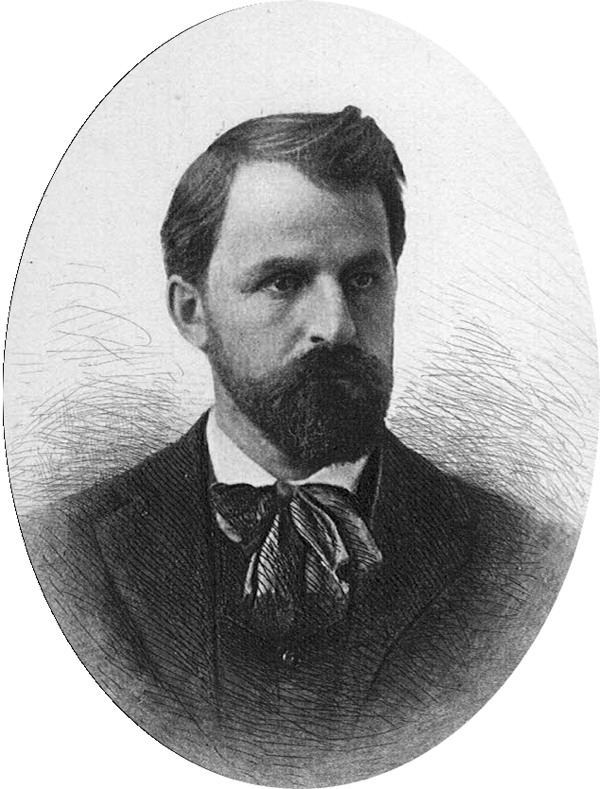
Hamlin Garland, 1890s (courtesy Keith Newlin).
Garland moved along until he happened upon the person he sought to meet, a big old man, stooping a little low now, and slow of gait, with scissors in hand, busily pruning his vines. The young journalist was now face-to-face with former Lieutenant General James Longstreet, Commander of the Army of Northern Virginias First Corps and senior subordinate to General Robert E. Lee, Commander of the Army of Northern Virginia, who referred to Longstreet as my old war-horse and the staff in my right hand while serving by his side from 1862 to 1865.
During the wartime years, Longstreet had cut the physical appearance of a soldier in the prime of his life. The men who served under Longstreet described him in many admiring ways and came up with different nicknames; the best fighter in the whole army, a bully general, a real bulldog fighter, Old Peter, and the Bull of the Woods after his commanding performance at the Battle of Chickamauga in September 1863. According to Thomas Goree, a First Corp aide-de-camp, Longstreet stood nearly six feet tall, was said to have weighed about 200 pounds, had light-brown hair and blue eyes, and wore a large, heavy set of whiskers and moustache, which hides the lower part of his face. Goree further described his chief as exceedingly punctual and industrious, while when he dresses up in his uniform and mounts his horse, I think that he presents a better appearance than any other man in the Army. The ladies all say that he is the handsomest. Gilbert Moxley Sorrel, another First Corp aide-de-camp, wrote similarly of the General, describing him as a soldier every inch, and very handsome, tall and well-proportioned, strong and active, a superb horseman and with an unsurpassed soldierly bearing. On Longstreets temperament, Goree deemed him one of the kindest, best hearted men I ever knew, who was happiest in the presence of ladies at the table [and] on the field of battle, while admitting that those not well acquainted with him think him short and crabbed. On the battlefield, Longstreet was, according to Goree, a man of but very few words, and keeps at all time his own counsels very reserved and distant toward his men, and very strict, but they all like him. Sorrel also described Longstreet as reserved and very serious, particularly after he lost three children to scarlet fever within one weeks time in the winter of 1862. After that personal tragedy, Longstreet was, according to Sorrel a changed man, where later years and time only lightened the memory of his sorrow.
Next page
